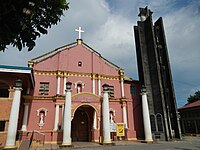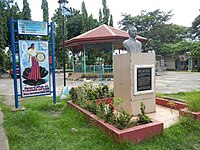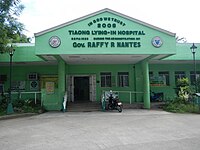Contents
Tiaong ([ˈtjaɔŋ]), officially the Municipality of Tiaong (Tagalog: Bayan ng Tiaong), is a first-class municipality in the province of Quezon, Philippines. According to the 2020 census, it has a population of 106,265 people.[3]
Tiaong is 35 kilometers (22 mi) from Lucena and 95 kilometers (59 mi) from Manila.
Etymology
According to local legends, Tiaong derived its name from the portmanteau of two words:
- Tiya (tia), Tagalog for aunt in reference to Doña Tating, a well-loved woman in the area; and
- Ong (oong) from the sound of her bull that signalled her nearby presence.[5]
History
In 1957, the following barrios were created:
Geography
Barangays
Tiaong is politically subdivided into 31 barangays. Each barangay consists of puroks and some have sitios.
- Anastacia
- Aquino
- Ayusan I
- Ayusan II
- Behia
- Bukal
- Bula
- Bulakin
- Cabatang
- Cabay
- Del Rosario
- Lagalag
- Lalig
- Lumingon
- Lusacan
- Paiisa
- Palagaran
- Poblacion I
- Poblacion II
- Poblacion III
- Poblacion IV
- Quipot
- San Agustin
- San Isidro
- San Jose
- San Juan
- San Pedro
- Tagbakin
- Talisay
- Tamisian
- San Francisco
Climate
| Climate data for Tiaong, Quezon | |||||||||||||
|---|---|---|---|---|---|---|---|---|---|---|---|---|---|
| Month | Jan | Feb | Mar | Apr | May | Jun | Jul | Aug | Sep | Oct | Nov | Dec | Year |
| Mean daily maximum °C (°F) | 27 (81) |
28 (82) |
30 (86) |
32 (90) |
31 (88) |
30 (86) |
29 (84) |
29 (84) |
29 (84) |
29 (84) |
28 (82) |
27 (81) |
29 (84) |
| Mean daily minimum °C (°F) | 20 (68) |
20 (68) |
21 (70) |
22 (72) |
24 (75) |
24 (75) |
24 (75) |
24 (75) |
24 (75) |
23 (73) |
22 (72) |
21 (70) |
22 (72) |
| Average precipitation mm (inches) | 52 (2.0) |
35 (1.4) |
27 (1.1) |
27 (1.1) |
82 (3.2) |
124 (4.9) |
163 (6.4) |
144 (5.7) |
145 (5.7) |
141 (5.6) |
100 (3.9) |
102 (4.0) |
1,142 (45) |
| Average rainy days | 12.0 | 8.1 | 8.8 | 9.7 | 17.9 | 22.6 | 26.2 | 24.5 | 24.6 | 22.0 | 16.7 | 14.9 | 208 |
| Source: Meteoblue[9] | |||||||||||||
Demographics
| Year | Pop. | ±% p.a. |
|---|---|---|
| 1903 | 9,527 | — |
| 1918 | 14,211 | +2.70% |
| 1939 | 27,179 | +3.14% |
| 1948 | 26,454 | −0.30% |
| 1960 | 26,084 | −0.12% |
| 1970 | 38,725 | +4.03% |
| 1975 | 43,245 | +2.24% |
| 1980 | 48,606 | +2.36% |
| 1990 | 60,662 | +2.24% |
| 1995 | 67,403 | +1.99% |
| 2000 | 75,498 | +2.46% |
| 2007 | 87,707 | +2.09% |
| 2010 | 91,599 | +1.59% |
| 2015 | 99,712 | +1.63% |
| 2020 | 106,265 | +1.26% |
| Source: Philippine Statistics Authority[10][11][12][13] | ||
Economy
Government

Elected officials
| Position | Name of official |
|---|---|
| District Representative (2nd Legislative District, Quezon) | Rep. David C. Suarez |
| Municipal Mayor | Vincent Arjay M. Mea |
| Municipal Vice Mayor | Roderick A. Umali |
| Municipal Councilors | Ma. Maja Alexandra E. Landicho |
| Romano P. Castillo Jr. | |
| Eugene P. Lopez | |
| Elton Rex B. Baldeo | |
| Rex D. Bautista | |
| Jessa L. Preza | |
| Jonas Bryson R. Atienza | |
| Tomas P. Ilao |
Tourism
- Moises Amat Escueta Ala-ala Park
- Saint John the Baptist Parish Church of Tiaong
- Escudero, Villa escudero
Education


Elementary schools
- Private school
- Southside Integrated School
- Kiddie Corner School Inc.
- Saint John Parochial School
- Gaudete Study Center Inc.
- Tiaong Christian Academy
- Maranatha Christian Academy
- Geriane Rainbow School
- Public School
- Anastacia Elementary School
- Lusacan Elementary School
- Del Rosario Elementary School
- Lagalag Elementary School
- Hilirang Buli Elementary School
- Tiaong East Elementary School
- Claro M. Recto Memorial Central School
High schools
- Private School
- St. John Parochial School
- Don Ysidro Memorial School
- Gaudete Study Center Inc.
- Public High School
- Recto Memorial National High School
- Lalig National High School
- Lusacan National High School
- Cabay National High School
- Gloria Umali National High School
- Paiisa National High School
- Talisay National High School
Colleges and universities
- Public Schools
- College
- Southern Luzon State University
- Private Schools:
- Asian Institute of Technology and Education
- Olinsterg College
Gallery
-
Saint John the Baptist Parish Church of Tiaong
-
Moises Amat Escueta Ala-ala Park
-
Tiaong Lying-In Hospital
-
Type 89 I-Go tank at Villa Escudero, Tiaong, Quezon Province
References
- ^ Municipality of Tiaong | (DILG)
- ^ "2015 Census of Population, Report No. 3 – Population, Land Area, and Population Density" (PDF). Philippine Statistics Authority. Quezon City, Philippines. August 2016. ISSN 0117-1453. Archived (PDF) from the original on May 25, 2021. Retrieved July 16, 2021.
- ^ a b Census of Population (2020). "Region IV-A (Calabarzon)". Total Population by Province, City, Municipality and Barangay. Philippine Statistics Authority. Retrieved 8 July 2021.
- ^ "PSA Releases the 2018 Municipal and City Level Poverty Estimates". Philippine Statistics Authority. 15 December 2021. Retrieved 22 January 2022.
- ^ Tayao, Annelle S. (March 10, 2012). "Tiaong has its come-ons". INQUIRER.net. Retrieved August 15, 2023.
- ^ Republic Act No. 1765 (21 June 1957), An Act Creating the Barrio of Matipunso in the Municipality of Tiaong, Province of Quezon, retrieved August 15, 2023
- ^ Republic Act No. 1766 (21 June 1957), An Act Creating the Barrio of Behia in the Municipality of Tiaong, Province of Quezon
- ^ Republic Act No. 1767 (21 June 1957), An Act Creating the Barrio of Bucal in the Municipality of Tiaong, Province of Quezon, retrieved August 15, 2023
- ^ "Tiaong: Average Temperatures and Rainfall". Meteoblue. Retrieved 27 January 2020.
- ^ Census of Population (2015). "Region IV-A (Calabarzon)". Total Population by Province, City, Municipality and Barangay. Philippine Statistics Authority. Retrieved 20 June 2016.
- ^ Census of Population and Housing (2010). "Region IV-A (Calabarzon)" (PDF). Total Population by Province, City, Municipality and Barangay. National Statistics Office. Retrieved 29 June 2016.
- ^ Censuses of Population (1903–2007). "Region IV-A (Calabarzon)". Table 1. Population Enumerated in Various Censuses by Province/Highly Urbanized City: 1903 to 2007. National Statistics Office.
{{cite encyclopedia}}: CS1 maint: numeric names: authors list (link) - ^ "Province of Quezon". Municipality Population Data. Local Water Utilities Administration Research Division. Retrieved 17 December 2016.
- ^ "Poverty incidence (PI):". Philippine Statistics Authority. Retrieved December 28, 2020.
- ^ "Estimation of Local Poverty in the Philippines" (PDF). Philippine Statistics Authority. 29 November 2005.
- ^ "2003 City and Municipal Level Poverty Estimates" (PDF). Philippine Statistics Authority. 23 March 2009.
- ^ "City and Municipal Level Poverty Estimates; 2006 and 2009" (PDF). Philippine Statistics Authority. 3 August 2012.
- ^ "2012 Municipal and City Level Poverty Estimates" (PDF). Philippine Statistics Authority. 31 May 2016.
- ^ "Municipal and City Level Small Area Poverty Estimates; 2009, 2012 and 2015". Philippine Statistics Authority. 10 July 2019.
- ^ "PSA Releases the 2018 Municipal and City Level Poverty Estimates". Philippine Statistics Authority. 15 December 2021. Retrieved 22 January 2022.






